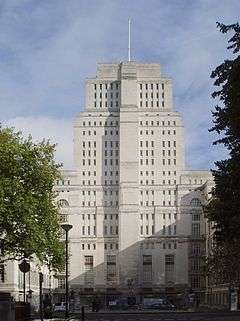Bloomsbury
| Bloomsbury | |
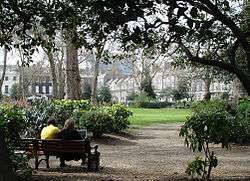 Bedford Square, one of Bloomsbury's garden squares |
|
 Bloomsbury |
|
| Population | 10,892 (2011 Census. Ward)[1] |
|---|---|
| OS grid reference | TQ305825 |
| London borough | Camden |
| Ceremonial county | Greater London |
| Region | London |
| Country | England |
| Sovereign state | United Kingdom |
| Post town | LONDON |
| Postcode district | WC1, NW1 |
| Dialling code | 020 |
| Police | Metropolitan |
| Fire | London |
| Ambulance | London |
| EU Parliament | London |
| UK Parliament | Holborn and St Pancras |
| London Assembly | Barnet and Camden |
Coordinates: 51°31′34″N 0°07′04″W / 51.5262°N 0.1178°W
Bloomsbury is an area in the West End, central London, forming part of the London Borough of Camden and located between Euston Road and Holborn. It was developed by the Russell family in the 17th and 18th centuries into a fashionable residential area. It is notable for its array of garden squares,[2] literary connections (exemplified by the Bloomsbury Group), and numerous cultural, educational and health-care institutions. Although Bloomsbury was not the first area of London to have acquired a formal square, Bloomsbury Square, laid out in 1660 by Thomas Wriothesley, 4th Earl of Southampton, as Southampton Square was the first square to be named as such.[3] Much of the district was planned and built by James Burton.[4]
Bloomsbury is home to the University of London's central bodies and departments, including the Senate House Library and School of Advanced Study, and to several of its colleges, including University College London, the Institute of Education (IOE),[5] Birkbeck, the London School of Hygiene and Tropical Medicine and the SOAS, University of London. It is also home to the University of Law and New College of the Humanities. The numerous health-care institutions located in Bloomsbury include the British Medical Association, Great Ormond Street Hospital, the National Hospital for Neurology and Neurosurgery, University College Hospital and the Royal London Hospital for Integrated Medicine. London Contemporary Dance School and the Royal Academy of Dramatic Art and are also located in the area.
Bloomsbury is in the parliamentary constituency of Holborn and St Pancras. The western half of the district comprises Bloomsbury ward, which elects three councillors to Camden Borough Council.
History

The earliest record of what would become Bloomsbury is in the 1086 Domesday Book, which states that the area had vineyards and "wood for 100 pigs".[3] But it is not until 1201 that the name Bloomsbury is first noted, when William de Blemond, a Norman landowner, acquired the land.[6] The name Bloomsbury is a development from Blemondisberi – the bury, or manor, of Blemond. An 1878 publication, Old and New London: Volume 4, mentions the idea that the area was named after a village called "Lomesbury" which formerly stood where Bloomsbury Square is now,[7] though this etymology is now discredited.
At the end of the 14th century, Edward III acquired Blemond's manor, and passed it on to the Carthusian monks of the London Charterhouse, who kept the area mostly rural.
In the 16th century with the Dissolution of the Monasteries, Henry VIII took the land back into the possession of the Crown and granted it to Thomas Wriothesley, 1st Earl of Southampton.
In the early 1660s, the Earl of Southampton constructed what eventually became Bloomsbury Square. The Yorkshire Grey public house on the corner of Gray's Inn Road and Theobald's Road dates from 1676. The area was laid out mainly in the 18th century, largely by landowners such as Wriothesley Russell, 3rd Duke of Bedford, who built Bloomsbury Market, which opened in 1730. The major development of the squares that we see today started in about 1800 when Francis Russell, 5th Duke of Bedford removed Bedford House and developed the land to the north with Russell Square as its centrepiece.
Governance
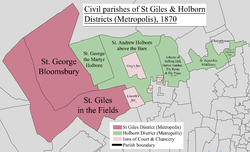

William de Blemond in the 13th century, a Norman, was the first landowner. Edward III acquired Blemond's manor, and passed it on to the Carthusian monks who governed it until Henry VIII granted it to the Earl of Southampton. The Russell family became landowners in the 18th century.
The area lay within the parishes of St Giles in the Fields and St George's, Bloomsbury,[8] which were absorbed into the St Giles District as part of the Metropolis Management Act 1855.[9] It is now controlled by the London Borough of Camden and part of the district is contained within the Bloomsbury ward. The district is situated in the parliamentary constituency of Holborn and St Pancras.
Geography

Bloomsbury has no official boundaries, but can be roughly defined as the square of territory bounded by Tottenham Court Road to the west, Euston Road to the north, Gray's Inn Road to the east, and either High Holborn or the thoroughfare formed by New Oxford Street, Bloomsbury Way and Theobalds Road to the south.[3] Bloomsbury merges gradually with Holborn in the south, with St Pancras and King's Cross in the north-east and with Clerkenwell in the south-east.
The area is bisected north to south by the main road Southampton Row/Woburn Place, which has several large tourist hotels and links Tavistock Square and Russell Square – the central points of Bloomsbury. The road runs from Euston and Somers Town in the north to Holborn in the south.
East of Southampton Row/Woburn Place are the Grade II listed Brunswick Centre, a residential and shopping centre,[10] and Coram's Fields children's recreation area. The area to the north of Coram's Fields consists mainly of blocks of flats, built as both private and social housing, which is often considered part of St Pancras[11] or King's Cross[12] rather than north-eastern Bloomsbury. The area to the south is generally less residential, containing several hospitals, including Great Ormond Street, and gradually becomes more commercial in character as it approaches Holborn at Theobald's Road.
The area west of Southampton Row/Woburn Place is notable for its concentration of academic establishments, museums, and formal squares. Here are the British Museum and the central departments and colleges of the University of London, including Birkbeck College, University College London, the School of Oriental and African Studies, and the University of London's School of Advanced Study. The main north-south road in west Bloomsbury is Gower Street which is a one-way street running south from Euston Road towards Shaftesbury Avenue in Covent Garden, becoming Bloomsbury Street when it passes to the west of the British Museum.
Parks and squares
Bloomsbury contains some of London's finest parks and buildings, and is particularly known for its formal squares. These include:

- Russell Square, a large and orderly square; its gardens were originally designed by Humphry Repton. The square is a short distance from Russell Square tube station.
- Bedford Square, built between 1775 and 1783, is still surrounded by Georgian town houses.
- Bloomsbury Square has a small circular garden surrounded by Georgian buildings.
- Queen Square, home to the National Hospital for Neurology and Neurosurgery.
- Gordon Square, surrounded by the history and archaeology departments of University College London, as well as the former home of John Maynard Keynes, the economist. This is where the Bloomsbury Group lived and met.
- Woburn Square and Torrington Square, home to other parts of University College London.
- Tavistock Square, home to the British Medical Association; its eastern edge was the site of one of the 7 July 2005 London bombings.
- Mecklenburgh Square, east of Coram's Fields, one of the few squares which remains locked for the use of local residents.
- Coram's Fields, a large recreational space on the eastern edge of the area, formerly home to the Foundling Hospital. It is only open to children and to adults accompanying children.
- Brunswick Square, now occupied by the School of Pharmacy and the Foundling Museum.
Culture
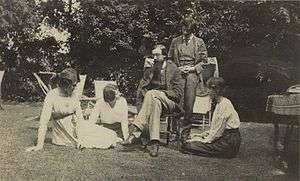
Historically, Bloomsbury is associated with the arts, education, and medicine. The area gives its name to the Bloomsbury Group of artists, the most famous of whom was Virginia Woolf, who met in private homes in the area in the early 1900s,[13] and to the lesser known Bloomsbury Gang of Whigs formed in 1765 by John Russell, 4th Duke of Bedford. The publisher Faber & Faber used to be located in Queen Square, though at the time T. S. Eliot was editor the offices were in Tavistock Square. The Pre-Raphaelite Brotherhood was founded in John Millais's parents' house on Gower Street in 1848.
The Bloomsbury Festival was launched in 2006 when local resident Roma Backhouse was commissioned to mark the re-opening of the Brunswick Centre, a residential and shopping area. The free festival is a celebration of the local area, partnering with galleries, libraries and museums,[14] and achieved charitable status at the end of 2012. As of 2013, the Duchess of Bedford is a festival patron and Cathy Mager is the Festival Director.[15][16]
Educational institutions
Bloomsbury is home to Senate House and the main library of the University of London, Birkbeck College, Institute of Education, London School of Hygiene and Tropical Medicine, School of Pharmacy, School of Oriental and African Studies, and the Royal Veterinary College and University College London (with the Slade School of Fine Art), a branch of the University of Law, London Contemporary Dance School, the Royal Academy of Dramatic Art, and Goodenough College. Other colleges include the University of London's School of Advanced Study, the Architectural Association School of Architecture in Bedford Square, and the London campuses of several American colleges including the University of California, University of Delaware, Florida State University, Syracuse University, New York University, and the Hult International Business School.
Museums
The British Museum, which first opened to the public in 1759 in Montagu House, is at the heart of Bloomsbury. At the centre of the museum the space around the former British Library Reading Room, which was filled with the concrete storage bunkers of the British Library, is today the Queen Elizabeth II Great Court, an indoor square with a glass roof designed by British architect Norman Foster. It houses displays, a cinema, a shop, a cafe and a restaurant. Since 1998, the British Library has been located in a purpose-built building just outside the northern edge of Bloomsbury, in Euston Road.
Also in Bloomsbury is the Foundling Museum, close to Brunswick Square, which tells the story of the Foundling Hospital opened by Thomas Coram for unwanted children in Georgian London. The hospital, now demolished except for the Georgian colonnade, is today a playground and outdoor sports field for children, called Coram's Fields. It is also home to a small number of sheep. The nearby Lamb's Conduit Street is a pleasant thoroughfare with shops, cafes and restaurants.
The Dickens Museum is in Doughty Street. The Petrie Museum and the Grant Museum of Zoology are at University College London in Gower Street.
Hospitals
Great Ormond Street Hospital for Children and the Royal London Hospital for Integrated Medicine (formerly the Royal London Homoeopathic Hospital) are both located on Great Ormond Street, off Queen Square, which itself is home to the National Hospital for Neurology and Neurosurgery (formerly the National Hospital for Nervous Diseases). Bloomsbury is also the location of University College Hospital, which re-opened in 2005 in new buildings on Euston Road, built under the government's private finance initiative (PFI). The Eastman Dental Hospital is located on Gray's Inn Road close to the Royal National Throat, Nose and Ear Hospital administered by the Royal Free Hampstead NHS Trust.
Business
In February 2010, businesses were balloted on an expansion of the InHolborn Business Improvement District (BID) to include the southern part of Bloomsbury. Only businesses with a rateable value in excess of £60,000 could vote as only these would pay the BID levy. This expansion of the BID into Bloomsbury was supported by Camden Council.[17] The proposal was passed and part of Bloomsbury was brought within the InHolborn BID.[18]
Controversy was raised during this BID renewal when InHolborn proposed collecting Bloomsbury, St Giles and Holborn under the name of "Midtown", since it was seen as "too American".[19][20][21] Businesses were informed about the BID proposals, but there was little consultation with residents or voluntary organisations. InHolborn produced a comprehensive business plan aimed at large businesses.[22] Bloomsbury is now part of InMidtown BID with its 2010 to 2015 business plan and a stated aim to make the area "a quality environment In which to work and live, a vibrant area to visit, and a profitable place in which to do business".[23]
Churches
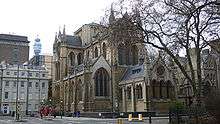
Bloomsbury contains several notable churches:
- St George's Church, located on Bloomsbury Way in the south of the area, was built by Nicholas Hawksmoor between 1716 and 1731. It has a deep Roman porch with six huge Corinthian columns, and is notable for its steeple based on the Tomb of Mausolus at Halicarnassus and for the statue of King George I on the top.
- The Early English Neo-Gothic Church of Christ the King on Gordon Square. It was designed for the Irvingites[24] by Raphael Brandon in 1853. Since June 10, 1954 it has been a Grade I listed building.
- St Pancras New Church on the northern boundary, near Euston station. This church was completed in 1822, and is notable for the caryatids on north and south which are based on the "porch of the maidens" from the Temple of the Erechtheum.
- The church of St George the Martyr in Queen Square was built 1703–06,[25] and was where Ted Hughes and Sylvia Plath married on Bloomsday in 1956.[26]
- Bloomsbury Central Baptist Church in Shaftesbury Avenue, is the central church of the Baptist denomination. It was opened in 1848, having been built by Sir Samuel Moreton Peto MP, one of the great railway contractors of the age.[27]
Transport
The area surrounding Bloomsbury has several London Underground stations, although only three of these (Russell Square, King's Cross St. Pancras and Euston Square) have entrances in Bloomsbury itself. The other stations, located on the fringes of Bloomsbury, are Euston, Goodge Street, Warren Street, Tottenham Court Road, Holborn, and Chancery Lane.
The mainline rail stations Euston, King's Cross and St. Pancras are all just north of Bloomsbury. Since 14 November 2007, Eurostar services have relocated to St Pancras, promising shorter journey times to Paris and Brussels and better connections to the rest of the UK.
Bloomsbury is also the site of the disused British Museum tube station.
It is well served by buses, with over 12 different routes running south down Gower Street, London|Gower Street and both north and south through Russell Square.[28] Route 7 goes along Great Russell Street, past the British Museum, and on to Russell Square.
One of the 13 surviving taxi drivers' shelters in London, where drivers can stop for a meal and a drink, is in Russell Square.[29]
Notable residents
- Ada Ballin (1863–1906), magazine editor and writer on fashion[30]
- J. M. Barrie (1860–1937), playwright and novelist, lived in Guilford Street and 8 Grenville Street when he first moved to London;[31] this is where Barrie situated the Darlings' house in Peter Pan.[32]
- Vanessa Bell (1879–1961), painter, sister of Virginia Woolf, lived at 46 Gordon Square.
- William Copeland Borlase M.P. (1848–1899), died bankrupt and disowned by his family at 34 Bedford Court Mansions.
- Vera Brittain (1893–1970) and Winifred Holtby (1898–1935) lived at 58 Doughty Street.
- Randolph Caldecott (1846–1886), illustrator, lived at 46 Great Russell Street.
- William Cavendish, 3rd Duke of Devonshire (1698–1755), sold the Old Devonshire House at 48 Boswell Street.
- Charles Darwin (1809–1882), lived at 12 Upper Gower Street in 1839.[33]
- George Dance (1741–1825), architect, lived at 91 Gower Street.
- Charles Dickens (1812–1870), novelist, lived at 14 Great Russell Street, Tavistock Square and 48 Doughty Street.
- George du Maurier (1834–1896), artist and writer, lived at 91 (formerly 46) Great Russell Street.
- Benton Fletcher (1866–1944), housed his keyboard collection at the Old Devonshire House, 48 Boswell Street, in the 1930s and 40s.
- Ricky Gervais (born 1961), comedian, lived until recently in Southampton Row, Store Street and owned one of the penthouses in Bloomsbury Mansions in Russell Square, WC1.
- Mary Anne Everett Green (1818–1895), Calenderer of State Papers, author of Lives of the Princesses of England, mother of Evelyn Everett-Green, a prolific 19th-century novelist.
- Philip Hardwick (1792–1870) and Philip Charles Hardwick (1822–1892), father and son, architects, lived at 60 Russell Square for over ten years.
- John Maynard Keynes, (1883–1946), economist, lived for 30 years in Gordon Square.
- Emanuel Litvinoff (1915–2011), author, poet, playwright and human rights campaigner, lived for 46 years in Mecklenburgh Square.
- Edmund Lodge (1756–1839), officer of arms and writer on heraldry, died at his Bloomsbury Square house on 16 January 1839.[34]
- Bob Marley (1945–1981), musician, lived in 34 Ridgmount Gardens for six months in 1972.
- Charlotte Mew (1869–1928), poet, was born at 30 Doughty Street and lived there until the family moved nearby to 9 Gordon Street, in 1890.
- Dorothy L. Sayers (1893–1957), novelist lived at 24 Great James Street from 1921–1929. Her main female character Harriet Vane also lived in Bloomsbury.
- Alexei Sayle (born 1952), English stand-up comedian, actor and author.[35]
- John Shaw Senior (1776–1832) and John Shaw Junior (1803–1870), father and son, architects, lived in Gower Street.
- Catherine Tate (born 1968), actress and comedian, was brought up in the Brunswick Centre, close to Russell Square.
- Virginia Woolf (1882–1941), author, essayist, and diarist, resided at 46 Gordon Square.
- Thomas Henry Wyatt (1807–1880), architect, lived at 77 Great Russell Street.
- John Wyndham (1903–1969), lived at the Penn Club in Tavistock Square (1924–38) and then (except for 1943–46 army service) at the Club's present address, 21–22 Bedford Place, off Russell Square, until his marriage in 1963 to Grace Isabel Wilson, who had left in the next room at the Club.
- William Butler Yeats (1865–1939), poet, dramatist and prose writer, lived at Woburn Walk.
See also
References
- ↑ "Camden Ward population 2011". Neighbourhood Statistics. Office for National Statistics. Retrieved 20 October 2016.
- ↑ Guide to London Squares. Retrieved 8 March 2007.
- 1 2 3 The London Encyclopaedia, Edited by Ben Weinreb and Christopher Hibbert. Macmillan London Ltd 1983
- ↑ Burton's St. Leonards, J. Manwaring Baines F.S.A., Hastings Museum , 1956.
- ↑ "Bloomsbury Colleges PhD Studentships". IOE London. Institute of Education. 2013. Retrieved 1 December 2013.
- ↑ Camden Council Local History. Retrieved 8 March 2007.
- ↑ 'Bloomsbury', Old and New London: Volume 4 (1878), pp. 480–89 Date accessed: 8 March 2007
- ↑ Sir Walter Besant and Geraldine Edith Mitton, "Holborn and Bloomsbury: The Fascination of London". Adam & Charles Black, London, 1903. Retrieved 2010-07-26.
- ↑ "London History - London, 1800-1913 - Central Criminal Court". www.oldbaileyonline.org. Retrieved 2010-07-26.
- ↑ Brunswick Centre – Restoration. Retrieved 8 March 2007.
- ↑ View London. Retrieved 8 March 2007.
- ↑ Corams Fields. Retrieved 8 March 2007.
- ↑ Fargis, Paul (1998). The New York Public Library Desk Reference – 3rd Edition. Macmillan General Reference. p. 262. ISBN 0-02-862169-7.
- ↑ "Preview: The Bloomsbury Festival". Londonist. Londonist. 16 October 2012. Retrieved 8 October 2013.
- ↑ "History". Bloomsbury Festival. Bloomsbury Festival. October 2013. Retrieved 8 October 2013.
- ↑ "The Team". Bloomsbury Festival. Bloomsbury Festival. October 2013. Retrieved 8 October 2013.
- ↑ "Council supports proposed expansion of Business Improvement District inholborn accessed 13 March 2010". Camden.gov.uk. 2009-11-09. Retrieved 2010-07-06.
- ↑ Bloomsbury, Holborn and St Giles business improvement district renewal ballot – announcement of result accessed 13 March 2010 Archived 6 March 2010 at the Wayback Machine.
- ↑ "Bloomsbury regroups for a bright new future accessed 13 March 2010". Thisislondon.co.uk. Retrieved 2010-07-06.
- ↑ "Holborn Midtown accessed 13 March 2010". Janeslondon.com. 2010-01-22. Retrieved 2010-07-06.
- ↑ Hill, Dave (2010-01-25). "Bid to re-brand Holborn, Bloomsbury and St Giles accessed 113 March 2010". Guardian. Retrieved 2010-07-06.
- ↑ "IH_BID2010_document_061109:IH_BID2010_document" (PDF). Retrieved 2010-07-06.
- ↑ "Our Purpose". Midtown BID. Retrieved 2012-12-20.
- ↑ Church of Christ the King. Retrieved 8 March 2007.
- ↑ St George's Bloomsbury. Retrieved 8 March 2007.
- ↑ Walking Literary London, Roger Tagholm, New Holland Publishers, 2001.
- ↑ Bloomsbury Central Baptist Church History Page. Retrieved 27 May 2014.
- ↑ TfL Central London Bus Routes. Retrieved 8 March 2007.
- ↑ Cabmen's Shelters. Retrieved 24 August 2010.
- ↑ Ada Ballin, ODNB, Retrieved 6 October 2016
- ↑ Mackail, Denis: The Story of J.M.B. Peter Davies, 1941
- ↑ J.M. Barrie: Peter Pan, or the Boy Who Wouldn't Grow Up. Act I. Hodder & Stoughton, 1928
- ↑ Charles Darwin. Retrieved 8 March 2007.
- ↑ ODNB: Lucy Peltz, "Lodge, Edmund (1756–1839)" Retrieved 11 March 2014
- ↑ Alexei Sayle (8 October 2013). "Alexei Sayle: Bloomsbury by bike - video" (Video upload). The Guardian. Retrieved 8 October 2013.
Further reading
External links
 Media related to Bloomsbury at Wikimedia Commons
Media related to Bloomsbury at Wikimedia Commons-
 London/Bloomsbury travel guide from Wikivoyage
London/Bloomsbury travel guide from Wikivoyage - Bloomsbury area guide
- "UCL Bloomsbury Project". University College London.
 |
Regent's Park | Somers Town | St Pancras |  |
| Fitzrovia | |
Clerkenwell | ||
| ||||
| | ||||
| Soho | Covent Garden | Holborn |




